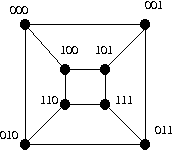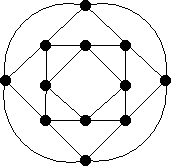
|

|

|

|

By the Heuristic, since d and f are degree 2, we must use edges bdc and cfb. Putting these together gives the closed circuit bdcfb.
Alternately, By the Heuristic, since d, e and f are degree 2, we must use edges bdc, bea and cfb. But now b has been used 3 times.



For v &isin V(G), d(v) = 3 + 11 = 14.
For v &isin V(H), d(v) = 4 + 12 = 16.
So every vertex has even degree and hence is Eulerian.
Note that there are 23 vertices in total.
For any pair of vertices u and v, either:
both are from G and so d(u) + d(v) = 14 + 14 = 28.
both are from H and so d(u) + d(v) = 16 + 16 = 32.
One from each and so d(u) + d(v) = 14 + 16 = 30.
In every case d(u) + d(v) > 23 and so the graph is Hamiltonian.
n and m both even.
n = m.
For each of the matchings given below

This is not a matching since 110 appears twice. We can still find an M-alternqating path (eg 100, 011, 111), but not M-augmenting ones
n/2 if n is even and (n-1)/2 if n is odd.
n/2 if n is even and (n-1)/2 if n is odd.
min(n,m)
Since T is a tree it is bipartite and so Hall's Theorem applies.
Since M is a perfect matching both parts are saturated.
Thus for every S ⊂ V(T), |S| ≤ |N(S)|.
In particular this implies that no two leaves have the same parent.
Since M is a perfect matching it covers every vertex of T.
In particular it must cover every leaf of T.
Thus (l,p) ∈ M, for every leaf l and its parent P.
Let T' be the graph obtained by deleting all the leaves of T
and their parents.
Consider M restricted to T', this is a perfect matching on T'.
Input a tree T.
| while(1) { | ||
| If T = empty return success. | ||
| S = empty | ||
| For each leaf l of T { | ||
| Let p be l's parent. | ||
| If p is already in M return "No perfect matching exists" | ||
| Otherwise add the edge (l,p) to M. | ||
| S = S ∪ {l, p} | ||
| } | ||
| T = T - S | ||
| } |
Peter Danziger, March 2008